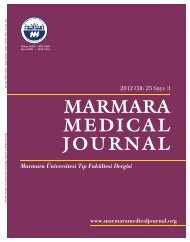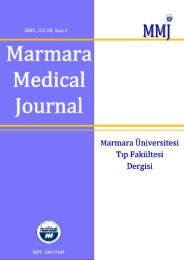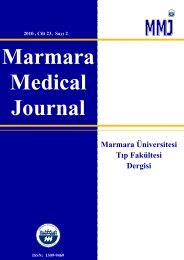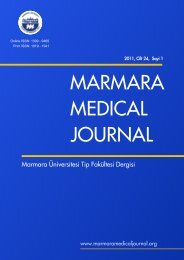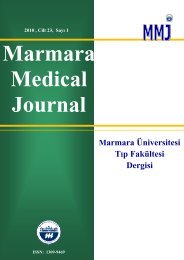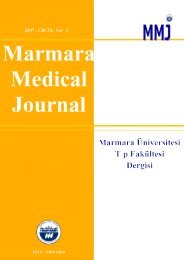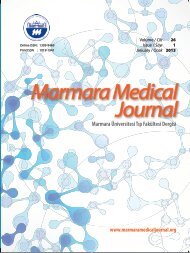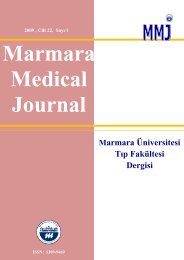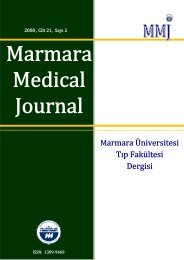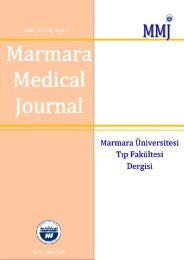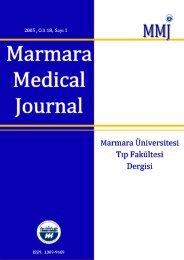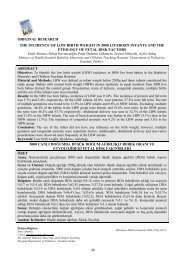Tam Metin PDF (4158 KB) - Marmara Medical Journal
Tam Metin PDF (4158 KB) - Marmara Medical Journal
Tam Metin PDF (4158 KB) - Marmara Medical Journal
- No tags were found...
You also want an ePaper? Increase the reach of your titles
YUMPU automatically turns print PDFs into web optimized ePapers that Google loves.
I. KAYGUSUZ, et alFactors affecting stem cell mobilizationINTRODUCTIONHigh dose chemotherapy, followed byautologous bone marrow transplantation is usedwidely in the treatment of hematological and somenon-hematological solid tumors. New developmentsin transplantation medicine have broadened itsusage. For a successful autologous bone marrowtransplantation and a rapid, stable hematologicalreconstitution, infusion of a sufficent number andadequate quality of stem cells is necessary. Inprevious clinical trials, it has been postulated that,infusion of 2x10 6 cells/kg of CD34+ stem cells isminimally sufficient for a safe neutrophil andthrombocyte engraftment at day 14 after thetransplantation. The transfer of hematopoieticprogenitor cells (HPCs) from bone marrow to theperipheral blood is called mobilization. Nowadays,peripherally mobilized stem cells is the preferredmethod over direct bone marrow harvesting forautologous bone marrow transplantation. Higherrates of cell collection, faster engraftment, lowerrates of procedural complications, easieraccesibility, lower rates of tumor contamination andfaster hematopoietic and immune reconstitution arethe attributed causes of this situation 1-3 . Becausesuccessful autologous bone marrow transplantationis strictly related to the infused quality and numberof stem cells, various studies have investigated thefactors affecting stem cell mobilization and thecauses of inadequate mobilization. Many factorsaffecting stem cell mobilization have been reported,previously. Diagnosis of the patient, chemotherapiesapplied and number of therapy lines beforeautologous transplantation, number of relapses,growth factors used for mobilization, type ofapheresis devices used, leukocyte and CD34+ cellcount at the first day of apheresis can all affect thesuccess of stem cell mobilization. Several studieshave reported distinct and controversial resultsabout these factors. The reason for this disparitycan be attributed to small sample size, inclusion ofdifferent heterogenous mobilization protocols to theanalysis or the absence of exact criteria forunsuccessful mobilization. The purpose of this studyis to evaluate the factors affecting stem cellmobilization in patients treated with high dosetherapy followed by hematopoietic peripheral stemcell rescue.PATIENTS and METHODSIn this study we retrospectively analysed154 patients treated with autologous bone marrowtransplantation between the years 1993 and 2010,followed at the Bone Marrow Transplantation Unit,Hematology Division, <strong>Marmara</strong> University Hospital.A total of 180 harvesting procedures were applied.In eleven cases, harvesting was done from bonemarrow and these cases were excluded from thestudy. One hundered and fortythree patients and169 apheresis procedures for peripheral stem cellharvesting were analysed. Daily apheresis wasperformed using continuous flow blood cellseparators of the companies Fresenius orHaemonetecs. Median age was 48 (range 18-66).Eighty one (56.6%) patients were male, 62 (43.4%)patients were female. For the 143 patientsanalysed, the diagnoses were: multiple myeloma in67 patients (46.9%), acute leukemia in 11 patients(7.7%), Hodgkin’s Disease in 31 patients (21.7%),non-Hodgkin’s lymphoma in 33 patients (23.1%) anda solid tumor in only one patient (0.7%). Before theapheresis procedure, the median number of diseaserelapse was one (range 0-5), the median number oftreatment lines received was two (range 1-6); themedian time between the diagnosis to the apheresisprocedure was 13 months (range 1-228). Fortythreepatients (30.1%) received involved field radiationtherapy before the apheresis procedure. For stemcell mobilization, Filgrastim was used in 89 patients(52.7%) while Lenograstim was used in 80 (47.3%)patients. For stem cell harvesting, a Freseniusapheresis device was used in 69 patients (40.8%),while a Haemonetics apheresis device was used in100 patients (59.2%). The median apheresis cyclefor one mobilization period applied to the patientswas 3 days (range 1-4). Median WBC count at thefirst day of apheresis was 35800/μL (range 6900-96500). Median peripheral blood CD34+ cell countat the first day of apheresis was 15/μL (range 0-125). Median harvested total cell/kg was 11.43 x 10 8(range 1.94 x 10 8 –26.30 x 10 8 ).Median CD34+cell/kg count in the harvested product was 4.21 x10 6 (0.15 x 10 6 –20.10 x 10 6 ).Statistical AnalysisAll continuous variables were dichotomizedby use of median values as a cut-off value.Comparisons were made by chi square, Yatescorrection, and Fisher’s exact test appropriately, inunivariate analysis. Time to apheresis wasestimated as the time elapsed between the date ofdiagnosis and the date of apheresis. Variables witha p value 3 apheresis cycles, harvested totalcell/kg value was higher (p=0.02). Apheresis deviceused was also analysed; harvested total cell/kg wasfound to be significantly higher with the Freseniusapheresis device than with the Haemoneticsapheresis device (p:0.03). Peripheral blood WBCcount at day 1 was associated with harvested totalcell/kg (p=0.0003). When the effect of G-CSF usedwas analysed, the total harvested cell/kg wassignificantly higher with Lenograstim over Filgrastimand this difference was statistically significant(p=0.0000005). (Table I).32<strong>Marmara</strong> <strong>Medical</strong> <strong>Journal</strong> 2011; 24 (1):31-37



